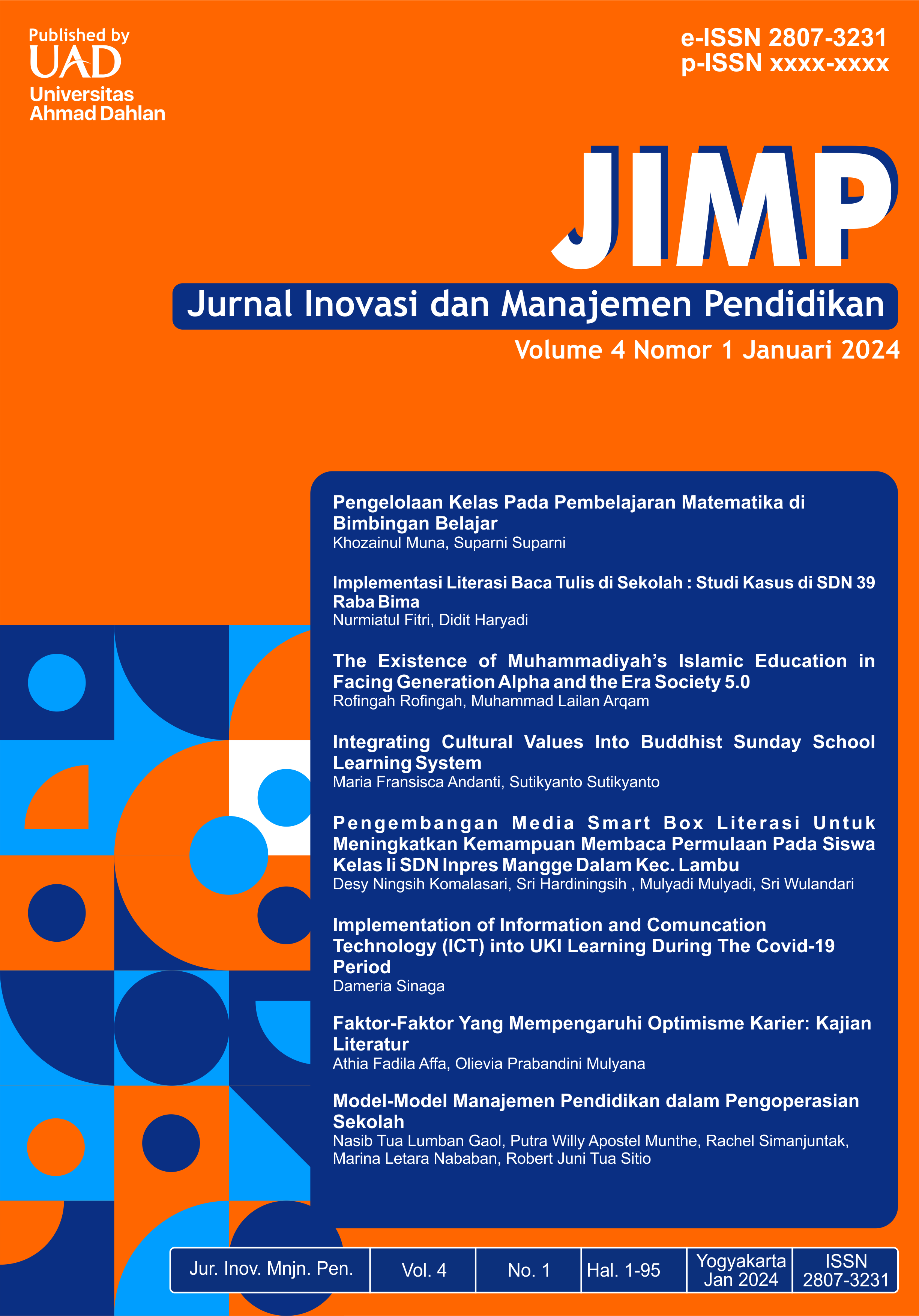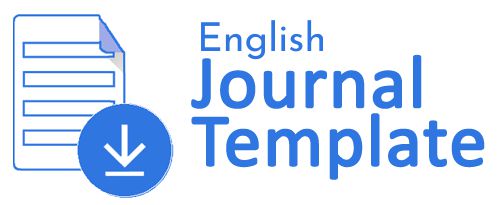Implementation of Information and Comuncation Technology (ICT) into UKI Learning During The Covid-19 Period
DOI:
https://doi.org/10.12928/jimp.v4i1.9370Keywords:
ICT (Information and Communication Technology), Learning, The Covid-19Abstract
In 2020, around February, the spread of the corona virus disease occurred throughout the world, causing changes in the economic, educational and health sectors. Likewise, in our country, Indonesia, learning has been disrupted by the presence of the corona virus disease, where previously learning was carried out in classrooms, but to prevent the spread of this virus from becoming widespread, learning was not carried out in schools but in individual homes. In order for learning to take place effectively even if you do not meet face to face, learning is carried out online. The results of this research show that using ICT learning is useful in supporting the learning process. By using ICT, teachers can do homework, mid-semester exams, final semester exams and can give grades to students without disturbing them and not being late in the class promotion process. As a result of using ICT, the learning process runs smoothly and effectively, providing motivation and making the learning process easier in getting broader information about learning at UKI. The purpose of this study is to facilitate learning during the COVID-19 period. We know that during the COVID-19 period all learning was carried out at home using daring learning. The study was conducted at the Christian University of Indonesia with a sample of 58 students who were randomly selected. And using the experimental method with a 2 x 2 factorial design.The findings of this study are to make students more active in learning. The results showed that learning through E-Learning can improve learning and competency-based curriculum especially UKI during the COVID-19 period
References
Anglin, Gary J. (ed), 1991, Instructional Technology: Past, Present, and Future, Englewood, CO: Libraries Unlimited.
Alwi, S. (2017). Problematika guru dalam pengembangan media pembelajaran. ITQAN: Jurnal Ilmu-Ilmu Kependidikan, 8(2)
Ashby, Eric, 1972, The Fourth Revolution: Instructional Technology in Higher Education, A Carnegie Commission on Higher Education Report. New York: McGraw-Hill Book Co.
Dabbagh, Nada dan Brenda Bannan-Ritland, “Online Learning: Concept, Strategies and Application”, (Ohio: Pearson-Merril Prentice, 2005)
Donald, Ary, Lucy Cheser Jacobs, Asghar Razavieh, Instroduction to Research in Education. 3rd., New York: Holt, Rinahart and Winston, 1985.
Edward L. Vockell, Educational Research. New York: Macmillan Publishing CO., INC, 1983.
Ellul, Jacques, 1967, The Technological Society, New York: Alfred A. Knopf.
Fryer, Wesley A, 2002, Strategy for Effective Elementary Technology Integration, http://www.wtvi.com/teks/integrate/tcea2001 /powerpointoutline.pdf
Gay, L.R, Educational Research-Competencies for Analysis and Application. 4rd Ed. New York : Macmillan Publishing Company, 1992.
Issacc, Stephen and William B. Michael. Handbook In Research and Evaluation. Edits Publisher San Diego. California, 1982.
Joko Purwanto, Agus : Online Learning; Pelaksanaan dan Kendalanya; Studi Kasus Pelaksanaan Online Learning Mahasiswa S-2 MAPU dan MM di UT Copyright 2003-2008 IlmuKomputer.Com Artikel Memahami Lebih Lanjut tentang e-Learning1
Kerlinger, Fred N., Azas-azas Penelitian Behavioral. Jogya: Gajah Mada Press, 1995. (Alih Bahasa: Landung R simatupang & H.J Koesoemanto).
Linn L. Robert. Gronlund, Norman E. Measurement and Assessment in Teaching. Englewood Cliffs, New Jersey: Printice Hall, 1990.
Martyn Descombe, The Good Research Guide. For Small-Scale Social Research Project. Philadelphia: Open University Press, 2000.
Miarso, Yusufhadi, dkk., 1998, Jaringan dan Sistem Informasi NUSANTARA 21 : Aplikasi Bidang Pendidikan, Jakarta: Yayasan Litbang Telekomunikasi dan Telematika, naskah untuk penerbitan.
Miarso, Yusufhadi, dkk., 2004, Menyamai Benih TEKNOLOGI PENDIDIKAN: Pustekom DIKNAS
Moleong, Lexy J. Metode Penelitian Kualitatif. Jakarta : PT Remaja Rosdakarya (1990)
Moleong, Lexy J., Metodologi Penelitian Kualitatif. Bandung: Rosdakarya, 2000.
Moleong, Lexy J. Metode Penelitian Kualitatif Edisi Revisi. Jakarta : PT Remaja Rosdakarya (2004)
NIE, Singapore, General Typology of Teaching Strategies in Integrated Learning System, http://www.microlessons.com
Stephen Isaac and William B Michael, Handbook In Research and Evaluation. Second edition. San Diego: EdITS Publishers, 1982.
Sugiyono. Metode Penelitian Pendidikan. Bandung :AlfaBeta (2008)
Sugiyono. Metode Penelitian Pendidikan, Pendekatan Kuantitatif, Kualitatif, dan R&D. Alfabeta. Jakarta, 2008
Suryaningtyas, Wahyu : Mengakrabkan Dosen Dengan Dunia Maya Dalam Rangka Pembelajaran Berbasis E-Learning Melalui Informal Learning Community (ILC)
The International Commission for the Study of Communication Problems, UNESCO, 1980, Many Voices, One World, London: Kogan Page.
UNESCO Institute for Information Technologies in Education (2002), Toward Policies for Integrating ICTs into Education, High-Level Seminar for Decision Makers and Policy Makers, Moscow
UNESCO (2002), Information and Communication Technologies in Teacher Education: a Planning Guide, Division of Higher Education.
Downloads
Published
How to Cite
Issue
Section
License
Copyright (c) 2024 Dameria Sinaga

This work is licensed under a Creative Commons Attribution-ShareAlike 4.0 International License.
This article's copyright is transferred to Universitas Ahmad Dahlan (UAD) if and when the item is accepted for publication. The undersigned hereby transfers any rights in and to the paper including without limitation all copyrights to UAD. The undersigned hereby represents and warrants that the article is original and that he/she is the author of the paper, except for material identified as to its source, with permission notices from the copyright owners where required. The undersigned represents that he/she has the power and authority to make and execute this assignment.
We declare that:
This paper has not been published in the same form elsewhere.
It will not be submitted anywhere else for publication before acceptance/rejection by this Journal.
Copyright permission is obtained for materials published elsewhere and which require this permission for reproduction.
Furthermore, I/We hereby transfer the unlimited rights of publication of the above-mentioned paper in whole to UAD. The copyright transfer covers the exclusive right to reproduce and distribute the article, including reprints, translations, photographic reproductions, microform, electronic form (offline, online), or any other reproductions of similar nature.
The corresponding author signs for and accepts responsibility for releasing this material on behalf of any co-authors. This agreement is to be signed by at least one of the authors who have obtained the co-author(s) assent where applicable. After submission of this agreement signed by the corresponding author, changes of authorship or in the order of the authors listed will not be accepted.
Retained Rights/Terms and Conditions
Authors retain all proprietary rights in any process, procedure, or article of manufacture described in the Work.
Authors may reproduce or authorize others to reproduce the Work or derivative works for the author's personal use or company use, provided that the source and the UAD copyright notice are indicated, the copies are not used in any way that implies UAD endorsement of a product or service of any employer, and the documents themselves are not offered for sale.
Although authors are permitted to re-use all or portions of the Work in other works, this does not include granting third-party requests for reprinting, republishing, or different types of re-use.







